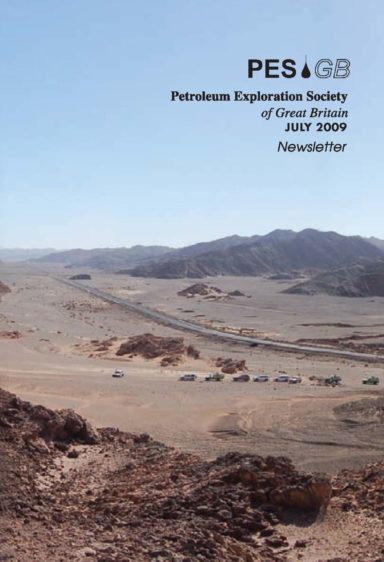PESGB July 2009
- DEVEX Review
- Northumberland Field Trip Review
- BG Energy Challenge 2009
- Jurassic Coast
- Iraq
Plus much more inside
President’s Page- Jon Gluyas
Late in the afternoon of Saturday 27th August 1859 among the pine-clad hills of western Pennsylvania and near the town of Titusville the drill bit hit a thin layer of oil bearing sandstone. It took about a day for the oil to rise from the bottom of the well a mere 70ft deep, to surface. Hardly a gusher but today, 150 years on, many see ‘Colonel’ Drake’s well as heralding the start of the petroleum industry*.
Oil was in big demand back then for lubrication and lighting and consequent upon the scarcity of this commodity, the oil price was volatile. Understanding the geology had little part in the early exploration forays. Instead prospectors used what we would call ‘direct hydrocarbon indicators’ and they would call seeps! Still even here debate raged. Was the tar lake in southern Trinidad, much beloved by Sir Walter Raleigh for caulking his boats, any indication at all that there may be liquid petroleum in the area? For a long time the arguments on both sides were strong.
Despite these tentative beginnings, the oil industry as we know it took off and petroleum geoscience started to evolve into the disciplines we practise today. The rate of petroleum discovery increased and the oil price stabilised at a few dollars a barrel. Curiously one of the unintended consequences of the growth in oil discoveries was the collapse in the whale-oil price. Did our industry save the whales? Well maybe, but the truth is always a little bit more complex. Conservatives would have it that market forces alone were responsible for the replacement of whale-oil by petroleum. However, hidden away the hand of government was on the tiller. In 1860 the US government determined that use of rock oil was best technology practise and this led to tax breaks – subsidies for the embryonic petroleum industry.
It seems to me that this piece of history has resonance today. The oil price is volatile. As a planet we are living on the spoils of the giant fields found in the 1940s, 1950s and 1960s. Despite some wonderful bits of technology in use, we are not replacing conventional oil as quickly as we are using it. However, there are alternatives; heavy oil, tar sands (the Faja of Venezuela has for example around 14 trillion barrels in place), tight gas (eg Venture’s lecture on Ensign, PESGB June 2009), basin centre gas, shale gas and so on. In order to help develop some of these alternatives the UK government has taken some tentative steps by altering the fiscal regime to favour heavy oil and small field development. Perhaps this is akin to the US government activity in 1860.
As each of us is aware provision of energy is not the only big problem facing the world’s population. Living with the consequences of burning that oil and gas is another. It may be a bit too late to ameliorate the 150 years of petroleum consumption but we do have the chance to slow the future build up of CO2 with carbon sequestration and storage. However, without intervention and the creation of an active market around such activity it will never be developed to the degree required. As petroleum geoscientists and reservoir engineers we understand the subsurface and the flow of fluids in porous media. We stand ready to play our part in the next 150 years and beyond whether it be providing the planet’s energy or looking after it’s emissions.


